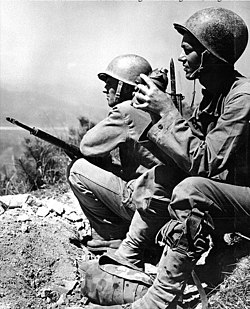Naktong Bulge
| First Battle of Naktong Bulge | |||||||
|---|---|---|---|---|---|---|---|
| Part of the Battle of Pusan Perimeter | |||||||
 US Marines resting on a newly captured position overlooking the Naktong River, August 19, 1950. |
|||||||
|
|||||||
| Belligerents | |||||||
|
|
|
||||||
| Commanders and leaders | |||||||
|
|
|
||||||
| Units involved | |||||||
|
1st USMC Provisional Brigade |
|
||||||
| Strength | |||||||
| 20,000+ | 7,000 | ||||||
| Casualties and losses | |||||||
| ~600 killed ~1,200 wounded or captured |
~1,200 killed ~2,300 wounded, captured, and deserted |
||||||
The First Battle of Naktong Bulge was an engagement between United States and North Korean forces early in the Korean War from August 5–19, 1950 in the vicinity of Yongsan (Yeongsan, Changnyeong county) and the Naktong River in South Korea. It was a part of the Battle of Pusan Perimeter, and was one of several large engagements fought simultaneously. The battle ended in a victory for the United States after large numbers of US reinforcements destroyed an attacking North Korean division.
On August 5, 4th Infantry Division, North Korean People's Army (NKPA), crossed the Naktong River in the vicinity of Yongsan, attempting to cut US supply lines to the north as well as gaining a bridgehead into the Pusan Perimeter. Opposing it was the 24th Infantry Division of the Eighth United States Army. Over the next two weeks, American and North Korean forces fought a bloody series of engagements inflicting heavy casualties on one another in a confusing series of attacks and counterattacks, but neither side was able to gain the upper hand. In the end, the US forces, aided by reinforcements, air support and heavy weapons, destroyed the invading North Korean force which was hampered by lack of supply and high desertion rates.
The battle was a turning point in the war for North Korean forces, which had seen previous victories owing to superior numbers and equipment. The American forces now had a numerical superiority and more equipment, including tanks and weapons capable of defeating the powerful North Korean T-34 tanks.
Following the 25 June 1950 outbreak of the Korean War after the invasion of the Republic of Korea (South Korea) by its northern neighbor, the Democratic People's Republic of Korea (North Korea), the United Nations decided to commit troops to the conflict on behalf of South Korea. The United States, a member of the UN, subsequently committed ground forces to the Korean peninsula with the goal of fighting back the North Korean invasion and to prevent South Korea from collapsing. However, US forces in the Far East had been steadily decreasing since the end of World War II, five years earlier, and at the time the closest forces were the 24th Infantry Division, headquartered in Japan. The division was understrength, and most of its equipment was antiquated due to reductions in military spending. Regardless, the 24th was ordered to South Korea.
...
Wikipedia
